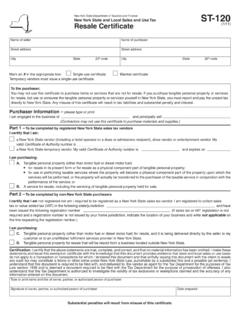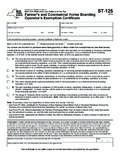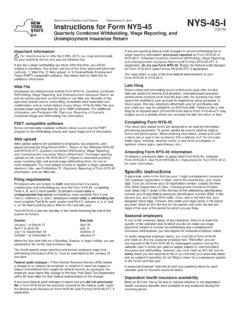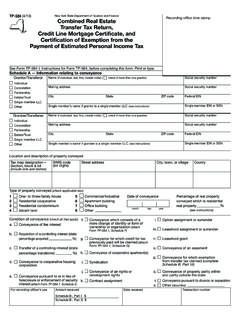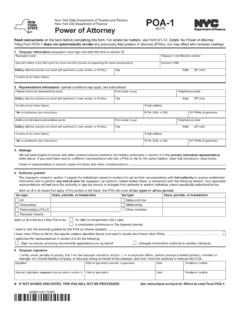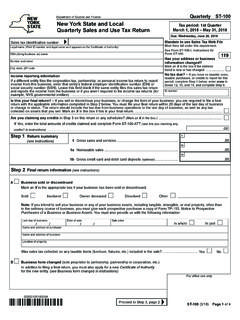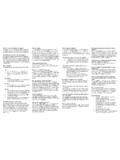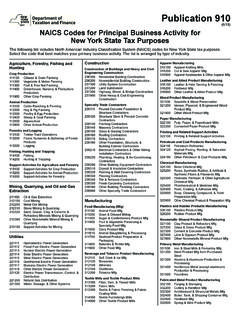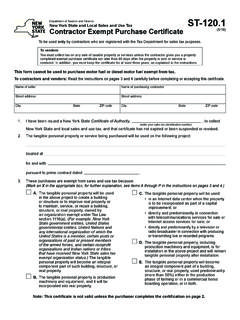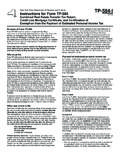Transcription of Form NYS-50 Employer's Guide to Unemployment Insurance ...
1 Employer s Guide toUnemployment Insurance ,Wage Reporting,and Withholding Tax(Revised January 2014) NYS-50 (1/14)This booklet contains information on: Employer rights, responsibilities, and filing requirements New York State Unemployment Insurance New York State wage reporting New York State, New York City, and Yonkers income tax withholding Reporting new or rehired employeesNew York State Tax Department and New York State Department of Labor ( Unemployment Insurance Division) addresses and telephone numbers are also included for further withholding tax tables and methods, see.
2 Publication NYS-50 -T-NYS, New York State Withholding Tax Tables and Methods Publication NYS-50 -T-NYC, New York City Withholding Tax Tables and Methods Publication NYS-50 -T-Y, Yonkers Withholding Tax Tables and MethodsThe information presented is current as of the publication s print date. Visit the Web at and for up-to-date 2 of 52 NYS-50 (1/14)Highlights of changes and other important informationUnemployment Insurance (UI) ReformShared Work ProgramEffective April 29, 2013, reforms to expand the Shared Work Program took effect. Shared Work allows participating employers to temporarily reduce the work hours of all or a group of employees in lieu of layoffs.
3 The reforms expand the program to more small businesses. Also, most employers accounts will not be charged for participation in Shared Work through August 2015. For more information, visit the Labor Department s Web site at must respond on timeEffective October 1, 2013, employers that fail to respond in a timely or adequate manner to a Notice of Potential Charges or any other request for information concerning the UI claim of a former employee may not be relieved of charges to their account. Please visit the Department of Labor s Web site to access SIDES (State Information Data Exchange System), which helps employers respond to information requests in a timely manner.
4 Also effective October 1, 2013, claimants will be subject to a penalty of 15% or $ , whichever is greater, if they fraudulently collect benefits. Revenues from penalties will be deposited into the Trust base and rate schedule changesEffective January 1, 2014, changes will be made to the financing of the Trust Fund. Beginning January 1, 2014, the UI wage base will be $10,300. The wage base will gradually increase each year, reaching 16% of the state s average annual wage in 2027. (See Annual Wage Base on page 12.) This will raise revenue more quickly to pay off debt and return the Trust Fund to a healthy level.
5 As the Trust Fund reaches a higher level of solvency, there will be an automatic shift to lower rate schedules, which will lower contribution rates for all employers. These reforms will greatly reduce the likelihood of having to borrow from the federal government and from incurring interest payments, which are passed on to employers in the form of the IAS (Interest Assessment Surcharge).Additional reforms that take effect January 1, 2014 include: All employers who are charged for benefits will be able to protest claims of former employees who have been terminated for misconduct or who voluntarily resigned provided they responded to the Notice of Potential Charges within the time prescribed on the notice.
6 If the protest is upheld, the employer may be relieved of charges for benefits paid. Under certain circumstances, claimants may not be eligible for benefits when receiving dismissal/severance pay. New measures to prevent and detect Unemployment Insurance fraud and abuse will be implemented. Employees disqualified for benefits for voluntarily quitting a job, misconduct, or refusing to accept suitable employment must earn ten times the previous weekly benefit rate with a new employer, to re-qualify for benefits. Extra job search assistance for the unemployed that will help them get back to work more quickly.
7 Any employer financed pension, whether financed partially or in full, will result in a reduction of benefits paid to the claimant equal to the weekly equivalent of the benefit rate increaseEffective October 1, 2014, the maximum weekly benefit rate will increase from $405 to $420. The benefit rate will then gradually increase to 50% of the state s average weekly wage by 2026. The minimum weekly benefit rate will also increase from $64 to $100, and will remain at that of workers Unemployment InsuranceEmployee misclassification occurs when an employer either (1) fails to report its employees to the state and pays them off-the-books or (2) improperly classifies its workers as independent contractors when they meet the legal standards for classification as employees.
8 Misclassifying workers can have a severe impact on workers and employers in industries where the practice prevails. For employers, it creates an unfair economic advantage and imposes higher costs on responsible employers. This makes them less competitive and more likely to be underbid by businesses that intentionally misclassify workers. For workers, it affects working conditions by encouraging unscrupulous employers to ignore labor protections, such as wage and hour requirements and safety and health regulations. We need your help to keep the system fair and equitable for everyone.
9 If you are aware of any employer committing fraud, you may report it anonymously by contacting the Department of Labor, Specialized Services and Liability Unit, by any of these methods: Visit our Web site at Call 1 866 435-1499 24 hours a day or (518) 485-2144 between 8:00 AM and 4:00 PM Fax information to (518) 485-6172 Report by mail to: NEW YORK STATE DEPARTMENT OF LABOR SPECIALIZED SERVICES AND LIABILITY UNIT BUILDING 12 ROOM 322 W A HARRIMAN CAMPUS ALBANY NY 12240 Online services for employersThe New York State Department of Labor Web site ( ) Employer Overview page contains several features for employers: New employers can register for UI online through Employer Registration.
10 Registered employers can access their employer account to obtain their UI rates and other important information regarding their account through Unemployment Insurance Online Services (UIOS). Unemployment Insurance Online Services also contains a link to the Department of Taxation and Finance s Web site that allows employers to file their quarterly returns FileEmployers can now electronically submit Form NYS-45, Quarterly Combined Withholding, Wage Reporting, and Unemployment Insurance Return, as well as submit payment via ACH debit on the Tax Department s Web site (see Need help?)
